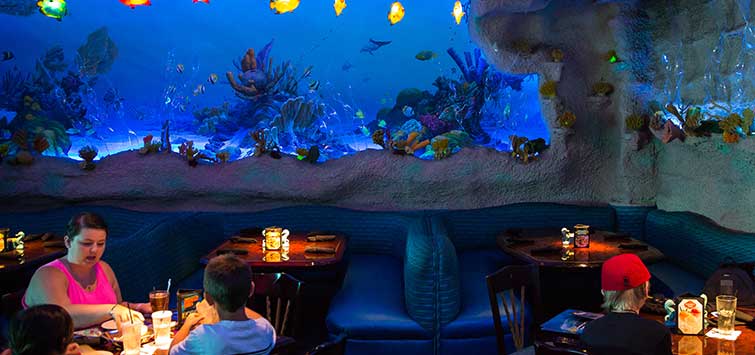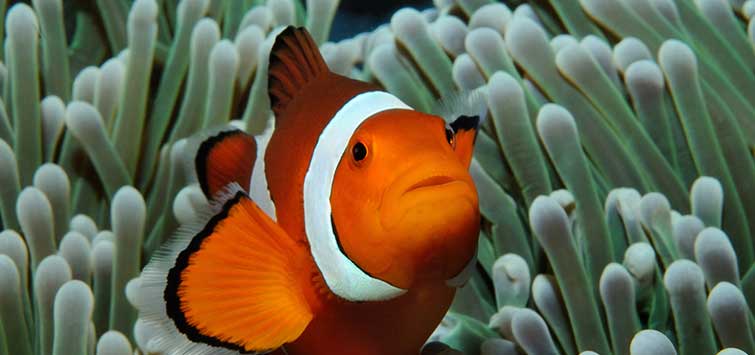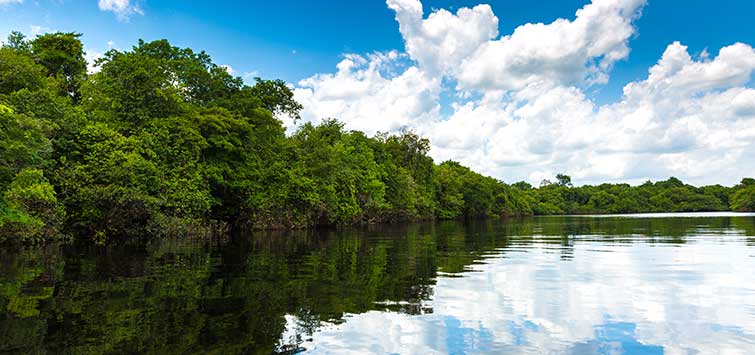Maintaining Monster Tanks: Inside Landry's Restaurant Aquariums
Author: Shari Horowitz
Imagine being in charge of a large number of aquariums, marine and fresh, large and small, in facilities scattered around the country. James Prappas, Director of Biology for Landry’s Restaurants Inc., gets to live that dream and shares his tale of the perfect job for a true fish lover with TFH’s own Associate Editor.
Living the Dream
James Prappas is, perhaps, living the dream of every fishkeeper. He is in charge of hundreds of tanks across the country, some of which are larger than 200,000 gallons. He gets to work with species from all over the world, including the massive predators featured on television. And he gets to design them all without the constraints of a typical homeowner’s budget. Yet to Prappas, “nothing is expendable.”
Prappas is the Director of Biology for Landry’s Restaurants, Inc., the casual dining and entertainment company in charge of places such as the Rainforest Cafe and the Downtown Aquarium. Since he has so many animals under his care, Prappas constantly reminds himself and his staff that “ultimately, the mortality rate in captivity is 100 percent.” Any animal taken from the wild will not be returned to its native habitat and will therefore die while in human custody. He takes this responsibility very seriously and ensures that all the animals are well cared for.
Business vs. Pleasure
Prappas will tell you that the first and arguably most important part of keeping an aquarium animal healthy is to know exactly which animal you have, and to know basically everything about it. Other pets are quite different from fish, as fish require an entire environment attuned to their needs, and virtually every fish has different and specific needs. So when fish are misidentified by importers, wholesalers, or pet shops, it can be especially difficult to design the proper setup.
He points out that it is critical to know exactly which fish you have if you are to succeed in its care. Every marine biologist on staff at Landry’s has to participate in an extensive training program before maintaining tanks in any of their facilities. Prappas does not believe in educating yourself at the expense of an animal.
A Short List of Specimens
Besides receiving intense training, people keeping tanks for a business have many other differences from aquarium hobbyists. “A lot of hobbyists don’t understand what we do,” he said. Unlike a home tank, where you have complete freedom to choose which animals can be included, Prappas maintains a strict list of what can and cannot be kept in the hundreds of tanks under his care. The list is based on a multitude of criteria, including animal survivability in captivity, ease of care, mortality rate during capture, aggression levels, etc. Although these considerations play a part in a hobbyist’s decision, they are vital to maintaining a professional tank.
“You will never see a Moorish idol in a Rainforest Cafe tank, or any of my other tanks for that matter,” he said. Prappas went on to add that many people would argue with him about that point—some hobbyists have had moderate success keeping the notoriously difficult fish—but he has to look at the big picture and consider their typically dismal success rate. He also refuses to allow venomous animals into most of his tanks because of the chance—no matter how small—that someone could get stung. “I don’t do a lot of experimenting in those 27 Rainforest Cafes,” he said.
Exceptions
Prappas does, however, make exceptions for marine biologists with extremely good track records who request to keep a particular animal on the prohibited list. All the exceptions must be approved first, and extensive research must be done before the introduction of the new fish. The staff must know what they are getting into before the purchase is made. Furthermore, as mentioned above, some species will never make it into a tank regardless of how skilled the keeper is.
Many of the tanks in the larger chain restaurants may look similar since they operate under such rigid restrictions, but the rules are much different for the two Downtown Aquarium complexes (in Denver, Colorado and Houston, Texas), which are certified by the Association of Zoos and Aquariums (AZA). The AZA-certified facilities operate as part public aquarium, part restaurant, and part entertainment complex. There are also two Aquarium restaurants that are smaller and uncertified, but benefit from wider latitude in terms of choices of what they can keep.
Education
In accordance with the mission statement of the AZA, the Downtown Aquariums have a primary focus on education and conservation. In the first place, the aquaria feature a much broader range of animals, often in exhibits that focus on a specific biotope or region. For example, Prappas said you would never find an African fish in a Louisiana Black Bayou exhibit. There is a Gulf of Mexico oil rig exhibit to showcase some relatively local flora and fauna, which is quite different from Stingray Reef, where children get the opportunity to touch some stingrays and invertebrates, even if they come from different regions. They offer both guided and self-guided tours to enhance the educational value of the visit.
Diving and Snorkeling
For those who enjoy a more hands-on approach to learning, there are diving and snorkeling opportunities, starting with children as young as six, in the larger tanks at Denver. You can even get one of several scuba certifications (PADI Underwater Digital Photographer, PADI AWARE Fish ID, PADI Scuba Review, and PADI Peak Performance Buoyancy) by diving in one of the exhibits.
For the Kids
Outside of what is available to the general public are specific educational partnerships that the aquariums engage in. They have programs with the Girl Scouts and Boy Scouts, who can earn merit badges and belt loops and pins in topics related to oceanography and zoology. The aquariums offer field trips, teacher workshops, and outreach programs for local school districts. There are also opportunities for kids to spend a day with trained scientists who operate the aquarium exhibits while going behind the scenes with the animals.
The Houston Downtown Aquarium offers a special program for children with cancer who are unable to leave a sterile room in the M. D. Anderson Cancer Center. Since the kids cannot be exposed to anything that can compromise their immune systems (i.e., any props used in a show that could carry germs and allergens), the marine biologists on staff make a monthly presentation they can watch on television. They then have the opportunity to ask the scientists questions in real-time.
The program has been so successful and beneficial to the children in Houston that Prappas would like to, in the near future, set up a similar arrangement with a hospital in Denver. Additionally, he is trying to negotiate a program there for children who have homeless parents.
Conservation
The other half of the AZA mission statement focuses on conservation, and the Downtown Aquariums have multiple organizations they work with to that end. In general, there are two levels of conservation practiced by the aquariums—local and corporate. As a company, Landry’s helps to support groups such as The Nature Conservancy, The Ocean Project, WildAid, and the Wildlife Alliance.
The Houston Downtown Aquarium
The Houston Downtown Aquarium keeps rare white tigers, so one year they worked with the Wildlife Alliance and funded a ranger station to help stop the poaching of tigers and other animals in Cambodia. The following year they outfitted a boat with WildAid to help combat the practice of shark finning off the Galapagos Islands. They also helped to fund a wildlife rehab hospital. Prappas says he does not know what conservation effort they will support this year, but they will give what they can.
Denver Efforts
One local effort revolves around the fact that these are also the only facilities that house live coral. In Denver, specifically, there is a 4000-gallon living reef tank. In this tank, coral frags are periodically broken off and sold to pet stores at extremely low prices. The pet stores are then allowed to mark the frags up—within reason—and sell them to hobbyists. Landry’s uses the money from the frags to benefit the various conservation organizations they support. The program has the benefit of allowing hobbyists access to corals they wouldn’t normally find at a pet shop. Additionally, none of the coral had to be collected in the wild, which is beneficial to the environment.
SECORE
Furthermore, they donated some frags to Sexual Coral Reproduction (SECORE), a network of research institutions and public aquariums dedicated to maintaining captive coral stock collections and establishing a genetic bank, among other scientific pursuits. While fragging is a commonly used and environmentally friendly way of sharing corals among hobbyists, it is a form of asexual reproduction that does nothing to increase the amount of genetic diversity. SECORE is working on sexual reproduction techniques—which do increase genetic diversity—for endangered captive corals.
Other Work
In addition to propagating corals, the aquariums breed various types of fish. To reduce the pressure on wild stocks of Banggai cardinalfish Pterapogon kauderni, they are bred and used throughout the various Landry’s locations. Seahorses and freshwater stingrays are bred for the same reason. They are also traded for conservation purposes to help keep a well-mixed genetic line among the captive stocks.
After breeding and raising piranhas, they were given out to nine institutions. The sawfish, which is critically endangered and listed under the IUCN Red List of Threatened Species and CITES Appendix II, is kept by Landry’s. They are now putting males and females together in the display tank. Since little is known about sawfish breeding habits, and sharks rarely propagate in aquaria, Prappas doubts that anything will come of it. But he feels that it is still their responsibility to try.
The Denver facility actively works with the state of Colorado on various local projects, such as the cleanup effort at the nearby Platte River. Instead of simply helping aquatic life, they have supported the Raptor Rehabilitation Center, which helps rare, injured, and orphaned wild birds. In Houston they work with the state of Texas on its environmental initiatives. They also work with the Memorial Park Conservancy to raise money to preserve a local bird-watching trail in the state’s largest protected park. Prappas feels that it is important for both aquariums to feel good about being involved with their communities by picking local causes they are emotionally attached to.
Setting It All Up
Obviously the most common form of education and conservation practiced by all of Landry’s is teaching the public about what exactly is in those tanks, but what they don’t teach is exactly how the tanks are set up. In fact, this is another place where business differs widely from the hobby, since the business receives much more support when creating something new.
Setting Up the Biofilter
First of all, when beginning a tank in the hobby, it takes about 30 days from when the biofilter is installed until it is mature. For Prappas, there is virtually no wait. He knows exactly what he needs—filter, biomedia, pumps, etc.—well in advance, and most of it arrives before construction of the building is even complete. He finishes the tank filtration, minus the nitrifying bacteria, before the end of construction as well. He utilizes a company that grows nitrifying bacteria specifically for aquaria (although he could simply take some from another tank at Landry’s if he needed to).
However, he did note that for as long as he could remember, he kept multiple filters running on his own tanks so that when he wanted to set up a new one, the filter was ready to go without any waiting or disease issues. Ironically, he said that the hardest part of the entire process now is actually getting the bioload high enough at the outset to keep the large quantities of bacteria alive in the filter.
Prepping the Tank
In a pinch, Prappas can get a tank up and running in as little as five days, though admittedly, he prefers ten to be the absolute minimum. “You can call it cheating,” he said, “but we just take the 30 days and do it way beforehand.” And remember, it is much harder to tell the president of a company that one of the main attractions in a restaurant he or she is opening won’t be operational for another month than it is to tell a spouse that it will take a month before the tank looks pretty.
Prappas says that setting up a larger tank, such as the one he designed for the Golden Nugget casino in Las Vegas, takes longer and is harder. The Golden Nugget is worthy of its own special mention because it is not your average 200,000-gallon shark tank. It has a 3-story water slide that goes through the center of the tank, and a swimming pool around the outside to give people the feeling that they are swimming with the sharks.
Relating to the Hobby
Although there are a great many differences between the business and the hobby, there is still plenty of room for the two to work together. “I started off in the hobby; the hobby has always kept me well connected. I work with hobbyists and encourage my staff to do the same,” he said. Prappas got his first tank 38 years ago and has been in the fishkeeping business for 28 years. He calls hobbyists—whether they keep fish, reptiles, or something else—an eclectic bunch.
He said that many of the volunteers in the Deep Blue Sea Foundation program in Denver are hobbyists—this volunteer effort is now a part of the community there. Many of the other people employed at the aquariums come from the hobby industry. They serve in a wide variety of positions including life support specialists, educators, divers, and even curators.
Prappas is concerned that the hobby is not where it was 10 years ago. He believes that fewer kids have tanks today and instead prefer to spend their money on television and video games. He does hope that the aquariums can help spark interest in children, possibly inspiring a few to keep fish tanks.
Expanding Opportunities
Landry’s now has several projects that involve aquaria in some way. The boardwalk and Aquarium restaurant in Kemah, Texas, which housed the first Stingray Reef touch tank, were virtually destroyed by Hurricane Ike this year. Landry’s is now planning to not only rebuild the facility, but to make it larger and more like the Downtown Aquarium, although it is not likely to earn the AZA certification.
In terms of new construction, they are planning to build more T-REX restaurants, a dinosaur-themed spin-off of the Rainforest Cafe, which will include aquaria such as a 5000-gallon tank at the bar. Right now there are only two T-REX restaurants: one in Disney World in Florida, and the other in Kansas City. They are also building a restaurant next to the Golden Nugget Hotel and Casino that will hold a 50,000-gallon aquarium.
Final Words
With all the new construction and the pressure to make the best or most interesting aquariums possible, it might seem like Prappas would forget about the individual animals and instead focus on the big picture. While he does have to make decisions based on making money and taking care of resources, he has never become cynical. He cares about the animals so much that he has gone so far as to arrange surgery in the form of fixing jaws or pulling out barbs from some fish.
At the end of the interview, when asked for advice for hobbyists, he instead offered a simple mission statement of sorts: “I don’t like to see a lot of fish die, it pains me.”
See the full article on TFH Digital http://www.tfhdigital.com/tfh/200904/#pg113

.png?h=595&iar=0&w=2781&hash=5FD5E69473BCC22199FBFA2FB71B6033)



